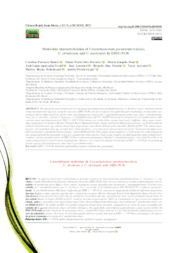Molecular characterization of Corynebacterium pseudotuberculosis, C. silvaticum, and C. auriscanis by ERIC-PCR.
Molecular characterization of Corynebacterium pseudotuberculosis, C. silvaticum, and C. auriscanis by ERIC-PCR.
Autoria: RAMOS, C. P.; DORNELES, E. M. S.; HAAS, D. J.; VESCHI, J. L. A.; LOUREIRO, D.; PORTELA, R. D.; AZEVEDO, V.; HEINEMANN, M. B.; LAGE, A. P.
Resumo: The aims of the present study were (i) to genotype Corynebacterium pseudotuberculosis, C. silvaticum, and C. auriscanis strains using enterobacterial repetitive intergenic consensus (ERIC-PCR), and (ii) to analyze the epidemiological relationships among isolates according to biovar (Equi and Ovis), species, host, and geographical origin of the C. pseudotuberculosis strains. Sixty-eight C. pseudotuberculosis, nine C. silvaticum, and one C. auriscanis, C. pseudotuberculosis ATCC® 19410? strain and the attenuated C. pseudotuberculosis 1002 vaccinal strain were fingerprinted by ERIC 1+2-PCR. Field strains were isolated from various hosts (cattle, buffaloes, sheep, goats, horses, dogs, and pigs) in six countries (Mexico, Portugal, Brazil, Equatorial Guinea, Egypt, and Israel). High genetic diversity was found among the studied Corynebacterium spp. isolates, clustering in 24 genotypes with a Hunter & Gaston diversity index (HGDI) of 0.937. The minimal spanning tree of Corynebacterium spp. revealed three clonal complexes, each associated with one bacterial species. Twenty-two genotypes were observed among C. pseudotuberculosis isolates, with an HGDI of 0.934. Three major clonal complexes were formed at the minimal spanning tree, grouped around the geographic origin of C. pseudotuberculosis isolates. These results reinforce the high typeability, epidemiological concordance, and discriminatory power of ERIC-PCR as a consistent genotyping method for C. pseudotuberculosis, which could be useful as an epidemiological tool to control caseous lymphadenitis. Moreover, our results also indicate the potential of ERIC 1+2-PCR for the genotyping of other species of Corynebacterium other than C. pseudotuberculosis.
Ano de publicação: 2022
Tipo de publicação: Artigo de periódico
Unidade: Embrapa Semiárido
Observações
1 - Por padrão são exibidas publicações dos últimos 20 anos. Para encontrar publicações mais antigas, configure o filtro ano de publicação, colocando o ano a partir do qual você deseja encontrar publicações. O filtro está na coluna da esquerda na busca acima.
2 - Para ler algumas publicações da Embrapa (apenas as que estão em formato ePub), é necessário ter, no celular ou computador, um desses softwares gratuitos. Sistemas Android: Google Play Livros; IOS: iBooks; Windows e Linux: software Calibre.
Acesse outras publicações
Acesse a Base de Dados da Pesquisa Agropecuária (BDPA) para consultar o acervo completo das bibliotecas da Embrapa.

